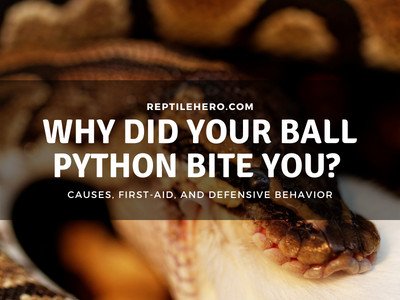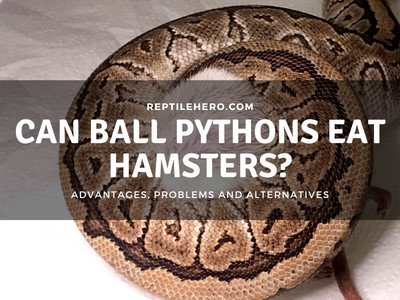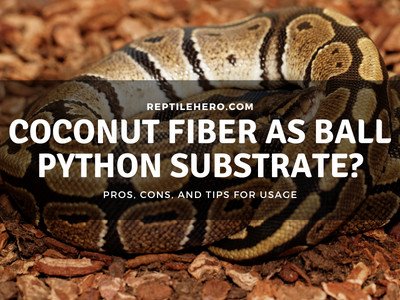Can You Overfeed Your Ball Python? (Is it Dangerous?)
Being overfed is one of the concerns owners have when keeping a ball python. As a concerned keeper, how would you know that your snake is overfed? Can this be life-threatening to your ball python?
In captivity, ball pythons can easily be overfed which can lead to various health issues like regurgitation, impaction, obesity, and stomach rot. Ball pythons are opportunistic hunters and will take food because they fear not being able to eat for a long time afterward.
A ball python’s appetite will vary depending on the individual. What should be the right frequency in feeding ball pythons? How can you prevent and treat an overfed snake? Find out more as you read below!
Can Ball Pythons Overeat?
Ball pythons can overeat especially when fed excessively in captivity. This is due to their innate instinct to eat until they are satisfied to prepare for possible fasting in the future.
In captivity, the recommended weight of feeders is about 10-15% of their body weight. With this amount, ball pythons can be fed once every 1 or 2 weeks.
In addition to this, ball pythons in the wild can overeat because they do not know when is the next chance for them to eat. They can also eat multiple preys in one seating to maximize their calorie intake in case there is no food.
What Frequency Is Considered Overfeeding For Ball Pythons?
The average digestion rate of a ball python is approximately 3-7 days (depending on prey size). So feeding ball pythons as often as 2 or 3 times per week is considered overfeeding.
Feeding ball python feeders that are above 15% of their weight and in quick successions can also be considered overfeeding.
If you feed your ball pythons similar to the method mentioned above, then there is a high chance that their feeding outpaces their metabolism (improper digestion). This can lead to health issues caused by overfeeding.
4 Signs of an Overfed Ball Python
Overfed ball pythons can be determined by checking the following factors: 1) body condition, 2) fasting, 3) constipation, and 4) lethargy.
1. Body Condition
Overfeeding can cause a ball python to become overweight or obese. These can be physically determined by looking at their body condition and shape.
Ball pythons have different growth rates. Some can even be twice as large/long within a year compared to others in the same clutch. Because of this, there is no standard weight to determine if the snake is overweight or not.
To determine if they are at a healthy weight or not, their overall body condition needs to be examined.

Ball pythons with the ideal body have a triangular-shaped body. Their spine also has a rounded peak and there should be no fat wrinkles when coiled.
Underweight ball pythons, on the other hand, tend to have a spine with a sharp peak and a concave belly. While overweight ones have a round-shaped body and a hidden or dimpled spinal peak.

My adult male ball python, Choco, has been eating 5 adult mice per month for the past 5 years he has been with me. I can say that he has the ideal body condition for an adult male ball python since I have no plans to breed him.
Breeder males need to be fatter compared to the photo above because they need to be conditioned for 1–3 months of possible fasting due to the breeding season.
2. Fasting
If a ball python refuses food for long periods then it might be caused by being overfed. In the wild, ball pythons can take large amounts of food and then fast for several months.
Fasting typically happens when you frequently overfeed your ball python. If there has been a large build-up of food, their natural response will be hiding and fasting for a long time.
They will also refuse food if you are feeding them before they can even fully digest their last meal (outpacing their metabolism).
Ball pythons commonly fast for a week to upwards of 2 months. They are adapted to fasting and have digestive organs that are well-suited to adjusting for dormancy and digestion [1].
Besides being overfed, ball pythons will refuse food due to:
- Husbandry problems
- Stress
- Respiratory infections
- Parasitic Infestations
Fun Fact: Ball pythons can survive for long periods without food. There are even reports that their ball python fasted for about a year! So do not worry too much if you leave your ball python without food for a week.
3. Constipation
Most of the time, constipation in ball pythons is caused by excessive food intake. Constipation happens when there is a build-up of wastes like feces and urates in the cloaca which makes it hard to pass through.
If you are overfeeding your snake, it will probably lead to constipation because the fecal matter inside the cloaca keeps on building up into a large mass.
Additionally, larger prey is sometimes not digested properly if fed in quick succession (once or twice a week). Hence, a large prey should only be fed once or twice a month to prevent constipation.
>>Learn more about ball python constipation in our article does ball python poop smell?
4. Lethargy
Overfed ball pythons are usually slow-moving due to constantly digesting large amounts of food which is energetically costly for them. They can also have slow movements due to fat build-up.
Digestion is a strenuous process for ball pythons with almost 70% of their energy consumed to assist in digesting a large prey [2].
Since overfed ball pythons have a longer digestion time, they tend to move very slow or look weak during this duration.
Ball pythons that have been fed large size/quantity feeders, must be allowed at least a week of rest after digestion before feeding it again [3].
If a ball python constantly eats food without rest from digestion, it can lead to a shorter lifespan due to organ failure.
4 Risks of Overfeeding to Ball Pythons (With First Aid Tips)
In general, overfeeding is an unhealthy practice for ball pythons. Some of the risks associated with overfeeding include: 1) regurgitation, 2) impaction, 3) obesity, and 4) stomach rot
1. Regurgitation
Overall, the most common risk in overfeeding ball pythons is regurgitation. This typically happens when there is too much food inside a snake’s stomach, in addition to stress and cold. It will result in the python spitting the undigested food back out.
Since overfed ball pythons take in large amounts of food, they can even regurgitate it without getting stressed. It happens when there is too much food in their stomach or if the prey item is too large. They can readily spit it back out.
Pro Tip: Ball pythons must be left alone for at least 48 hours after feeding before handling. This will lessen the chance of causing stress and regurgitation to a ball python.
However, regurgitation can hurt the ball python’s throat due to the digestive fluids that come with the food.
If your ball python regurgitates a feeder, the first thing you should do is to remove the excreted feeder. Then double-check their husbandry parameters like temperature and humidity (80–90°F and 50–70%).
Then I recommend at least 2 weeks of rest for their throat to fully heal before attempting to feed them.
Pro Tip: Regurgitation can also be caused by illnesses and parasitic infestations. If they exhibit wet/bloody stool, lethargy, wheezing, and other peculiar behavior, I suggest bringing it to a veterinarian.
2. Impaction
In most cases, impaction in ball pythons is caused by prolonged constipation. If overfed, there can be an accumulation of hard fecal matter in their cloaca which can cause prolapse and can be fatal.
Impaction can happen when a ball python has not defecated even though there is a visible bump or a “sausage butt” near the cloaca of the ball python.
When overfeeding ball pythons, the large amount of food would often be improperly digested. This will result in hard stools which are difficult to release and will eventually build up.
In cases of impaction, I suggest giving your ball python a warm soak (85-88°F) for 10-15 minutes once or twice a week.
Warning: It is not advisable to soak your ball python often because this procedure can cause a lot of stress which can lead to other implications like regurgitation.
Ball pythons do not need this kind of treatment and it should only be done if there is any problem like impaction, stuck shed, mite infestation, or if a veterinary doctor recommends it.
If your ball python still has a sausage butt for a month even after having warm baths, I highly recommend going to a veterinarian for an assisted removal and to determine the cause.
3. Obesity
Ball pythons that are overfed tend to be overweight or obese. Obesity can cause harmful fat build-up in organs, primarily the liver.
Ball pythons are sedentary snakes which makes them prone to obesity. That is why overfeeding a ball python can cause excessive fat absorption.
Fatty liver disease or hepatic lipidosis is common amongst obese ball pythons. The snake’s liver is in charge of metabolizing protein, carbohydrates, fats, etc.
So if there is too much fat in the liver, it would cause improper nutrient absorption and cause metabolic problems [4]. If your ball python show signs of a fatty liver, it is advisable to immediately go to a veterinarian.

Here are 3 tips to help an obese ball python gradually lose weight:
- Let the ball python roam in a room or outdoors for 10-15 minutes at least once a week. Make sure to supervise your snake at all times.
- Provide a hot spot of around 87-90°F to aid the ball python’s metabolism which will gradually lessen excess fat.
- Reduce feeding frequency and feeder size. For example, If you feed your ball python a 100-gram rat once a week, try giving it once every 2 weeks or make it into a 70- gram rat. This will provide enough sustenance, at the same time will gradually decrease the unhealthy fat of your ball python.
4. Stomach Rot
Stomach rot, also known as gut infection, happens when the prey inside a ball python’s stomach rots before getting fully digested. It is caused by a combination of large amounts of food and cold temperature.
If overfed ball pythons are stuck in a constantly cold environment (75°F and below) during their digestion time, the risk of getting a gut infection will be higher.
Providing a hot side (87-90°F) for a ball python is highly recommended to help in food digestion before it rots in their stomach.
Vomiting a few days after eating is the main sign of stomach rot. If your ball python has vomited, I highly recommend bringing it to a veterinarian as soon as possible.
Proper Feeding Schedule for Ball Pythons to Avoid Overfeeding
To avoid overfeeding ball pythons, the main factors to keep in mind are feeding frequency and size/quantity of feeders. They should be fed at a proper rate to prevent health issues.
| Ball Python Weight (Grams) | Snake-Feeder Weight Ratio | Prey Size (Grams) | Feeding Frequency |
| 50-100 | 13-15% | 1 hopper mouse (8-10g) or rat fuzzy (8-12g) | Once every 5-7 days |
| 100-350 | 12-14% | 1 small adult mouse (12-18g) or rat pup (20-30g) | Once every 7 days |
| 350-500 | 11-13% | 1 jumbo mouse (30-50g) or juvenile rat (30-40g) | Once every 7 days |
| 500-900 | 10-12% | 2 jumbo mice (60-100g) or small adult rat (50-90g) | Once every 9-12 days |
| 900-1500 | 10% | 2 jumbo mice (80-130g) or small adult rat (70-120g) | Once every 14-21 days |
| Above 1500 | 8-10% | 2 jumbo mice (90-150g) or medium adult rat (90-150g) | Twice or once every 30 days |
In relation to the table above, the recommended ratio of a feeder’s weight is about 10-15% of the ball python’s mass.
As observed in the table, when the ball python’s weight hits 500 grams and above the recommended feeding frequency is reduced to almost once every 2 weeks. This is suggested because as they grow, ball pythons will be having slower metabolism.
After the digestion period, ball pythons need to revert their digestive organs to normal which prevents unhealthy straining of the organs. They need to have at least 3-7 days of rest after they have digested food.
Feeder-Snake Weight Ratio and Feeding Ball Pythons
The feeder-snake weight ratio also decreases as the mass of the ball python increases to decrease strain in their digestive system.
To better understand how to utilize the feeding table above here is an example of how I feed Choco my 1200-gram, 6-year-old male ball python:
| Ball Python Weight (Grams) | Snake-Feeder Weight Ratio | Prey Size (Grams) | Feeding Frequency |
| 1200 | 10% | 2 jumbo mice (60g each) or small adult rat (120g) | Once every 14 days |
Ball pythons can be fed either one or multiple feeders with no problems as long as it is within the recommended weight ratio.
>>Learn more about mice and rats as feeders in our article feeding mice and rats to a ball python
Further Questions
How to tell if a ball python is hungry?
One way to test if a ball python is hungry is to walk by its enclosure. If they are receptive or in a striking position to the body heat coming from a hand, then they are hungry.
How often does a ball python poop?
Each ball python is different in terms of defecating schedule. Most ball pythons poop 1-2 weeks after eating. Although some ball pythons regularly poop every 1-2 months.
Can ball pythons choke on their food?
Ball pythons cannot choke on their food, however, they can get suffocated during regurgitation. This can be caused by digestive fluids coming from the released meal that can block their windpipe or glottis trachea.
Summary of Overfeeding Ball Pythons
Generally, ball pythons can be overfed. This happens more often in captivity when they are given food more than they need. An overfed ball python can be determined through body condition, fasting, constipation, and lethargy.
In some cases, overfeeding can result in health issues like regurgitation, impaction, obesity, and stomach rot. These scenarios typically happen alongside improper husbandry and stress.
To avoid overfeeding a ball python, it is recommended to give them a feeder 10-15% of their body mass. The advisable frequency should be once a week or every 2 weeks. For larger prey, it can be given once a month.






